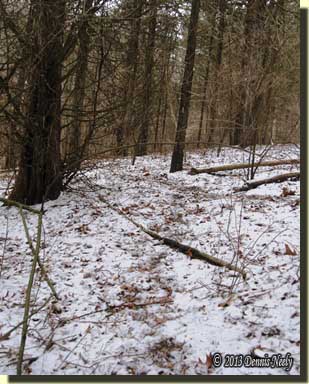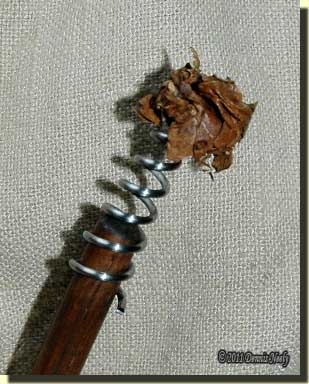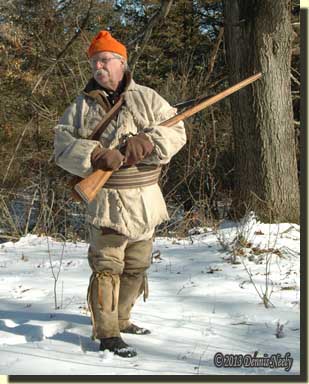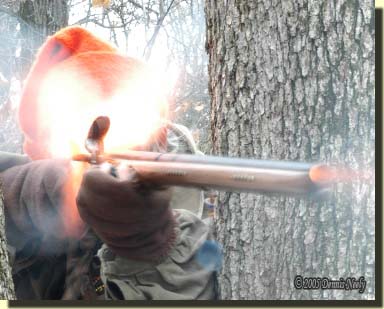Saturday, 19 November, 1763:
Two Sandhill cranes flew overhead. One chortled soft, the other trailed behind. The “caw, caw, caw, caw” of a lone crow, winging somewhere south, pierced the dense fog. A fox squirrel’s sharp bark hung heavy on that chilly morn. A branch stub, not cut clean by the tomahawk, irritated through the trade blanket and linen shirts.
That red cedar tree grew a third of the way down the east face of the hog-back ridge. Three older cedar trees loomed to the south, and the largest of all stood four trade gun lengths to the east. All its lower branches died years ago, offering obstructed vision of the lower trails while breaking up the returned white captive’s deathly shape. Beyond the trail at the base of the hill, the grayish tint of a heavy frost, intermixed with patches of Thursday night’s snowfall, provided a better view of the big swamp’s sedge grass.
 The long-barreled French fusil rested on the wool trade blanket that covered Mi-ki-naak’s red wool leggins. The still-hunt to that ambuscade cut the trail of a flock of turkeys. The woodsman expected to hear the birds cluck from their night roost, but that was not the case. Besides, the smoothbore’s breech held a solitary death sphere. Fresh venison was the immediate concern.
The long-barreled French fusil rested on the wool trade blanket that covered Mi-ki-naak’s red wool leggins. The still-hunt to that ambuscade cut the trail of a flock of turkeys. The woodsman expected to hear the birds cluck from their night roost, but that was not the case. Besides, the smoothbore’s breech held a solitary death sphere. Fresh venison was the immediate concern.
“Jay! Jay! Jay!” A blue jay screamed to the southwest. The hillside’s silence amplified the warning cries. One sentinel’s voice became two, then three, then more. A blue jay flew north to south, winging hard just above the mid-hill doe trail, no doubt intent upon joining the morning’s first ruckus—the first such melee heard in three days of hard hunting. “Perhaps a deer,” Mi-ki-naak thought to himself.
Keen eyes gave up on the southern hope and returned to watching the close-by trails. Ten minutes passed. A leaf crackled. A hoof scuffed. “Crunch…crackle…” The hoof-falls sounded distinctive, faint, yet not cautious or concerned. A small twig snapped. The deer walked on to the north, uphill and behind the cedar palisade, skirting the downwind side of the experienced woodsman. Sixty paces distant a white tail flicked side-to-side as a lean rump angled down the hill.
When it was well above the eastern tree line, the sun cut through the thick fog. Light spears plunged into the slope’s east face, but afforded little warmth as they struck the dark-dyed wool blanket. A pleasant hour passed. Nary an antler tip appeared. Hungry and disappointed, Mi-ki-naak rose to his feet and adjusted his blanket. With fusil in hand, his footfalls eased on to the north in the wake of the solitary doe.
What to do after an unsuccessful hunt?
Like it or not, all time traveling adventures must come to an end. At some point in the day, moccasins, regardless of which character they belong to, must cross over time’s threshold and return to the 21st century. After that particular sojourn, I slipped the fusil de chasse back into its buckskin sleeve and headed for home.
It is odd how experience and habit take over simple tasks. A recent question in the comment section of a Snapshot Saturday post brought that to light. Joe asked the question:
“What to do when you’re unsuccessful? Seems a huge pain to load the morning of the hunt, then use a ball puller or worm to pull the charge and shot/ball after an unsuccessful hunt. What’s your normal procedure? Obviously if you’ve fired your gun, you probably ought to clean that night. Boy what of the unfired gun? Just dump prime? Are there concerns (other than simple safety) with leaving a charge in the gun? Moisture/corrosion/etc?”
The answer to that question, rather those questions, is not simple. I spent some time thinking through the best way to answer, based on my own experience, and that is what this answer is, my experience. I’ll try to walk through my process and attempt to make it easy to understand the basis for each choice/practice.
Safety
The first consideration is always safety, for the living historian, his or her 18t-century hunting companions and his or her family members.
When my daughters lived at home, I discharged the load in “Old Turkey Feathers” at the end of the hunt, without exception. Being teenagers and on into college, they often had friends over, and I didn’t want a loaded gun in the house, modern or muzzleloader.
Where muzzleloaders are concerned, the definition of “loaded” can be confusing. The 2018 Michigan DNR’s Hunting Digest defines “unloaded” as the nipple uncapped and the hammer down for a percussion gun, or the pan free of priming, the frizzen up and the hammer down for a flintlock (page 19, Note). In either case, there is still a charge in the barrel.
I’m not comfortable with a charge in the barrel, and here is why. I once witnessed a noted bird hunter shooting sporting clays with his double flint shotgun. The first clay in the report pair was a standard disc thrown from downrange that dropped about ten yards in front of the shooter. He waited, and obliterated that settling bird. The second bird was a midi flying right to left, about 10 yards in front of the station. The shooter swung on that bird, his pan flashed, but the barrel did not discharge. In one swift motion, he pulled the frizzen into place and re-cocked the hammer. The gun snapped, then went off, breaking the bird about two feet above the ground. “This gun sometimes does that,” he said with a sheepish grin. “I can’t tell you how many pheasants I’ve killed with a flashed pan…” Yes, Virginia, a flintlock can go off with an empty pan!
Time of Day Considerations
In the 1980s and 1990s, I thought nothing of ending a hunt, unloading (dump the pan, frizzen up, hammer down) and walking back to the truck in the dark. Most nights I would arrive at the pickup fifteen to twenty minutes after the close of shooting hours. The majority of the time, I parked in one of three locations. Each location had a large, dead stump (I guess all stumps are dead) in a safe-to-shoot area. My habit was to prime and dump the round ball into a stump, which was twelve to fifteen yards from the truck. I discussed this practice with our local MDNR officer, and he saw no problem with it. If someone questioned the “late shot,” I had a fresh hole in the stump to “prove” what I did. Remember, this was twenty-plus years ago.
However, I no longer dump a load after shooting hours close, thanks to the advent of cell phones. A number of years ago I walked into an outdoor store and one of the customers was complaining about a neighbor shooting at waterfowl after hours. In the middle of his rant, he pulled out his cell phone and played a time-stamped video from about ten minutes after waterfowl shooting hours closed. The screen showed the neighbor’s pond and there was no question there were two shots, even though you could not see the muzzle flash, what was shot at or who did the shooting. Now the neighbor could have been hunting other game within legal hours, but how do you prove that? And was it even “the neighbor?”
In today’s world, guilt by cell phone or social media video accusation overrules due process in the realm of public opinion. I can’t count the number of times I’ve heard, “He’s always shooting after hours.” It’s not worth the hassle or the risk of tarnishing other traditional hunters with a bad impression.
Round Ball Loads
Prior to the close of shooting hours, I simply discharge the round ball. I case the gun, transport it to the eastern property line, and fire it into a box elder stump wedged up against the south wall in a gully. This keeps the muzzle blast away from most hunting areas and confines the “thunder” to one specific location, limiting the possibility of spooking game.
After shooting hours close, I pull the round ball at home at my work bench. Please remember that I load shot and round ball with leaves and grass as wadding. I no longer use a patched round ball in my smoothbores, and haven’t for five or so years. My current practice is to load with a wad over the powder and over the death sphere for the best accuracy.
 Each persona’s shot pouch contains a gun worm, a spiral wire that looks like a cone-shaped spring. When screwed to the bare end of the ramrod, the gun worm corkscrews into the over-shot or over-ball wad and pulls it with ease.
Each persona’s shot pouch contains a gun worm, a spiral wire that looks like a cone-shaped spring. When screwed to the bare end of the ramrod, the gun worm corkscrews into the over-shot or over-ball wad and pulls it with ease.
On occasion the gun worm will dislodge the round ball from the over-powder wad, but most times it won’t. The ball tends to create a pocket in the wad which holds the ball and wad firm over the powder charge. If it won’t work loose, I use the ball puller. The pulled ball ends up on the far edge of the bench, along with many others, waiting to be recycled the next time I fire up the lead pot.
Some living historians with a British persona load using the standard military rolled paper cartridge with a round ball in one end. After dumping the powder down the bore, the paper cartridge is inserted ball-end first so the empty paper that held the powder charge faces the muzzle. When the charge is tamped firm, the paper forms a wad over the ball. A gun worm will usually catch the paper and pull the ball out with it, making removing the load easy and simple.
And on rare occasions, I hunt squirrels with a .40-caliber Dickert rifle. I almost always discharge that load, because the small diameter of the ball coupled with the added diameter of the puller tends to wedge the patch and ball tighter in the rifled bore. If I have to pull the load, I dribble about six or eight drops of cleaning solvent (one part Murphy’s Oil Soap to two parts 90-percent Isopropyl alcohol) down the bore, let it set for a few minutes and then pull the ball. Plain water will wet the patch, but the soap in the cleaner makes the moist patch slippery. Once the ball starts to move, I do not stop pulling until it is out. I have used the same method on rifles up to .58-caliber with similar results.
Shot Loads
Back when I loaded with over-powder, fiber and over-shot wads, I would keep a loading rod in the truck with a ball-puller attached to pull the cards. With the over-shot card out, I would pour the shot into my hand and return it to the shot bag. This is a hold-over practice from when I first started hunting with Old Turkey Feathers. I only owned three pounds of #4 shot, and I was trying to be frugal. Non-toxic bismuth for waterfowl is another matter. Each charge averages over a dollar per shot—pull it and save it!
With leaf and/or grass wadding, the gun worm removes the over-shot wad. Sometimes I will pull the over-powder wad and dump the powder out, and at other times I’ll prime and discharge the powder load. I didn’t worry as much about the muffled “WHOOSH!” as the loud “BOOM!” This choice depends on location, what seasons are open and whether or not I’ve already fired the gun. There have been several instances where I wanted to see what the wads looked like after a day of hunting, so pulling the wads is a matter of wilderness classroom learning.
Every Muzzle Loading Gun is Different
I usually preface answers to loading/unloading with this statement: “Every muzzleloading gun is different.” A traditional black powder hunter has to learn what his or her favorite arm needs in the way of care and feeding. I’ve shot Old Turkey Feathers for 40 years. Those four decades have been filled with trial and error lessons, and I am still learning.
For example, I am now paying careful attention to Mi-ki-naak’s fusil de chasse. This trade gun was made in the 1980s, but it is “new” to me/him. A common trap many traditional hunters fall into is assuming what works for one smoothbore will work in another. Sometimes that is true, and sometimes it is not. None of us want to confront the moment of truth and find that that assumption is incorrect, especially when a fine goose wings away when it shouldn’t.
Old Turkey Feathers is a very forgiving smoothbore. If the first load in a clean bore is discharged, all that is needed is three or four damp patches to get her ready for the next day. The next morning, before reloading, I run a damp patch down the bore. Based on my experience, I can determine what condition the bore is in from that patch. Nine times out of ten the patch is light gray with no signs of rust. I load as I normally would.
 If I don’t make it out the next day, after about four days the patch shows surface rust. I take the time to run a few more patches down the bore, then load as usual. When plans change, as they often do, I take a few moments to run an oily patch down the bore. The damp patch before loading reminds me that I took this precaution, and from looking at the patch I can tell if more are needed.
If I don’t make it out the next day, after about four days the patch shows surface rust. I take the time to run a few more patches down the bore, then load as usual. When plans change, as they often do, I take a few moments to run an oily patch down the bore. The damp patch before loading reminds me that I took this precaution, and from looking at the patch I can tell if more are needed.
By comparison, if I shoot a number of shots, say two back-to-back rounds of quail walk, Old Turkey Feathers gets a thorough cleaning. If I try to get away with the “one shot” method of using a few patches, the bore shows a mix of fouling and a hint of surface rust the next day—thus the need to “know your gun.”
In the case of pulling the load and pouring the black powder out of the barrel, I run a couple of damp patches down the bore, just as I would if I discharged the load. Quite often the first patch brings up a few grains that remained stuck to the breech plug. If the second one is clean, I stop. The next morning, before loading, I run a damp patch down the bore and examine it. Again, nine times out of ten there is no problem and I commence loading.
Carrying a Load Over to the Next Day
A fair number of muzzle-loading hunters leave a load in a clean gun for several days of hunting. I don’t recommend this practice, first for family safety, as stated earlier, and second, because of the risk of damaging your gun’s bore. And then there is the cringe-worthy comment we’ve all heard at the beginning of the sport shooting season: “I left my muzzleloader loaded during deer season and just discovered it…”
Black powder is hygroscopic, meaning the granules attract and absorb moisture from the air. On high-humidity or rainy days, I usually pull the load and change the powder halfway through the day. This habit is a result of mistakes from years ago. Early on, I left a load in a rainy day, and when I went to discharge it, I discovered a bore filled with black, gooey mud. Lesson learned.
Being hygroscopic, a black powder load might gather moisture that the hunter is not aware of. If left overnight, the load will not produce the same breech pressures as a fresh charge and thus performance suffers. I have heard stories on the shooting range about folks who left a charge in a gun “for a day or so,” which turned into a week or more. The gathered dampness in the powder created “fouling” that began rusting the bore. Again, it’s just not worth the hassle or risk of potential damage.
For those of us that load with compost, leaves and grass for wadding, this same characteristic of black powder will pull moisture from damp leaves or a ball of green grass. For that reason, I pay careful attention to how “wet” the leaves or grass feel. When natural wad material displays any amount of moisture, I change the load mid-day. If not, you will hear and feel the difference, followed by a queasy wrenching of one’s stomach.
Moisture and Condensation
The forums and campfire conversations abound with discussions regarding condensation and/or resulting moisture from bringing a muzzleloader that has been outside in the cold into a warm environment. Horror stories abound, as do glowing reports of no problems. In the end, this topic falls in the category of “know your gun.”
When I return from a hunt that involves rain, snow or chasing in a wet glade, I always wipe Old Turkey Feathers down with a towel after pulling the load and swabbing the bore. The gun then returns to its deerskin, slip-on case/sleeve.
In the late 1970s, a living historian wasn’t serious about the shooting side of the hobby unless he or she had a hand-stitched deerskin case for that prized muzzleloader. I’ve used canvas, wool and oil-treated sleeves, along with zip-up padded gun cases. I have noticed condensation or moisture with all of them, but not with the deerskin. Again, this is my personal experience and my preference based on my observations in Lower Michigan. That may not be true in other climates or locations.
 The “know your gun” adage requires a certain amount of trial and error on the part of the traditional hunter. The best advice is to experiment in the wilderness classroom prior to a critical moment of truth. Whether pulling a load or dumping it off, the time to make a decision regarding any of the areas I’ve touched on is well before opening day.
The “know your gun” adage requires a certain amount of trial and error on the part of the traditional hunter. The best advice is to experiment in the wilderness classroom prior to a critical moment of truth. Whether pulling a load or dumping it off, the time to make a decision regarding any of the areas I’ve touched on is well before opening day.
For example, when I talk about dumping a load and using a couple of damp patches for a “light cleaning,” I base that statement on experience and careful observation. If you have a new-to-you rifle or smoothbore, load it and fire one shot. Give the bore a light cleaning, then put it in the gun safe. Use whatever method works for you as a reminder (cell phone alarm?) and run a patch down the bore eight hours later. Repeat at bed time, then the next morning. What did you discover? Repeat this lesson several times to confirm your result. Now you have a guideline to go by. However, be willing to make changes the minute the results change or don’t meet you hunting needs.
Everyone’s method is different. There are no right or wrong answers to the questions posed. I hope the comments help, Joe. And dear readers, thank you for your patience…
Give traditional black powder hunting a try, be safe and may God bless you.



2 Responses to What to do, what to do?